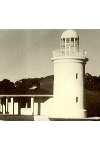Narooma Lighthouse Museum

Museum is part of the Visitors Centre. Montague Island is 7km (5.7 Nautical Miles) off Narooma, and is the largest inshore island on the NSW coast. It is now a nature reserve under control of NSW National Parks and Wildlife Service and is home to the largest sea bird/penguin colonies also possibly the most northerly bull seal "haul out" site of the NSW coast. Montague Island was discovered by the convict transport ship "Surprise" in 1790 and named after George Montague Dunk, Earl of Halifax. Because of its location and importance to shipping, the Government of the day decided to construct a lighthouse on the island. The lighthouse was completed in November 1881. When constructed the light had an intensity of 45 000 candellas. It was subsequently increased to 250 000 in 1910 and 357 000 in 1923. The light source was originally oil, then kerosene followed by pressurised kerosene mantle, before conversion to electric power in 1969, with a light intensity of 1,000,000 candelas. This mechanism was completely removed in 1986 and a battery of solar powered quartz halogen lamps installed in its place, radiating two beams of 120,000 candelas whilst consuming 75 watts of power. The dismantled original light mechanism was packed, prism by prism in individual cases surrounded by expanding foam sprayed in to protect the contents. This subsequently hardened around the contents. In October, 1986 the Narooma Apex Club wrote to the Department of Transport and Communication asking that the original light be returned to Narooma. This was agreed to, provided the light could be housed in a manner acceptable to the department. Following consultation with Eurobadalla Shire Council. Pending a decision on its ultimate destination, the whole of the mechanism was then restored in Sydney. Today the light is housed in an extension specially built, next to the visitors centre.
